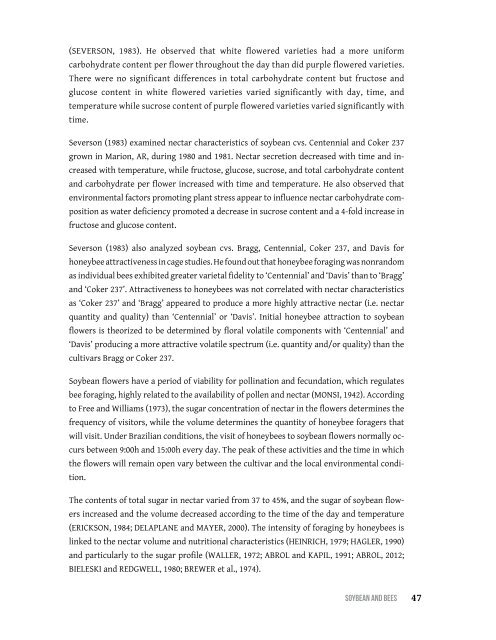Soybean and Bees
Create successful ePaper yourself
Turn your PDF publications into a flip-book with our unique Google optimized e-Paper software.
(Severson, 1983). He observed that white flowered varieties had a more uniform<br />
carbohydrate content per flower throughout the day than did purple flowered varieties.<br />
There were no significant differences in total carbohydrate content but fructose <strong>and</strong><br />
glucose content in white flowered varieties varied significantly with day, time, <strong>and</strong><br />
temperature while sucrose content of purple flowered varieties varied significantly with<br />
time.<br />
Severson (1983) examined nectar characteristics of soybean cvs. Centennial <strong>and</strong> Coker 237<br />
grown in Marion, AR, during 1980 <strong>and</strong> 1981. Nectar secretion decreased with time <strong>and</strong> increased<br />
with temperature, while fructose, glucose, sucrose, <strong>and</strong> total carbohydrate content<br />
<strong>and</strong> carbohydrate per flower increased with time <strong>and</strong> temperature. He also observed that<br />
environmental factors promoting plant stress appear to influence nectar carbohydrate composition<br />
as water deficiency promoted a decrease in sucrose content <strong>and</strong> a 4-fold increase in<br />
fructose <strong>and</strong> glucose content.<br />
Severson (1983) also analyzed soybean cvs. Bragg, Centennial, Coker 237, <strong>and</strong> Davis for<br />
honeybee attractiveness in cage studies. He found out that honeybee foraging was nonr<strong>and</strong>om<br />
as individual bees exhibited greater varietal fidelity to ‘Centennial’ <strong>and</strong> ‘Davis’ than to ‘Bragg’<br />
<strong>and</strong> ‘Coker 237’. Attractiveness to honeybees was not correlated with nectar characteristics<br />
as ‘Coker 237’ <strong>and</strong> ‘Bragg’ appeared to produce a more highly attractive nectar (i.e. nectar<br />
quantity <strong>and</strong> quality) than ‘Centennial’ or ‘Davis’. Initial honeybee attraction to soybean<br />
flowers is theorized to be determined by floral volatile components with ‘Centennial’ <strong>and</strong><br />
‘Davis’ producing a more attractive volatile spectrum (i.e. quantity <strong>and</strong>/or quality) than the<br />
cultivars Bragg or Coker 237.<br />
<strong>Soybean</strong> flowers have a period of viability for pollination <strong>and</strong> fecundation, which regulates<br />
bee foraging, highly related to the availability of pollen <strong>and</strong> nectar (monsi, 1942). According<br />
to Free <strong>and</strong> Williams (1973), the sugar concentration of nectar in the flowers determines the<br />
frequency of visitors, while the volume determines the quantity of honeybee foragers that<br />
will visit. Under Brazilian conditions, the visit of honeybees to soybean flowers normally occurs<br />
between 9:00h <strong>and</strong> 15:00h every day. The peak of these activities <strong>and</strong> the time in which<br />
the flowers will remain open vary between the cultivar <strong>and</strong> the local environmental condition.<br />
The contents of total sugar in nectar varied from 37 to 45%, <strong>and</strong> the sugar of soybean flowers<br />
increased <strong>and</strong> the volume decreased according to the time of the day <strong>and</strong> temperature<br />
(Erickson, 1984; Delaplane <strong>and</strong> Mayer, 2000). The intensity of foraging by honeybees is<br />
linked to the nectar volume <strong>and</strong> nutritional characteristics (Heinrich, 1979; Hagler, 1990)<br />
<strong>and</strong> particularly to the sugar profile (Waller, 1972; Abrol <strong>and</strong> Kapil, 1991; Abrol, 2012;<br />
BIELESKI <strong>and</strong> REDGWELL, 1980; BREWER et al., 1974).<br />
SoybeAn <strong>and</strong> bees<br />
47


